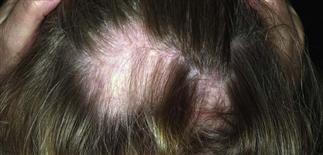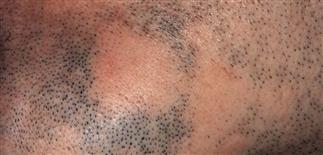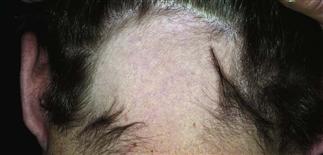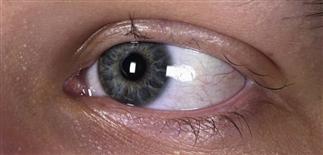151
Alopecia areata

Localized alopecia areata: round, discrete patches of hair loss. The scalp is smooth without scaling, erythema, or scarring.

Alopecia areata in the beard skin can be subtle and noted only as adjacent shaved hairs regrow. Affected beard area skin is smooth; the round patch is hairless without inflammation.

Alopecia areata of the occiput. This large hairless patch is characteristically round and devoid of hair.

Alopecia areata can affect any site of hair-bearing skin. Here, it has resulted in loss of eyelash hairs.
DESCRIPTION
A non-scarring hair loss. Typically rapid onset in sharply defined, usually round or oval area. Loss may be diffuse or focal, or band-like at scalp margins.
HISTORY
• Most common in children and young adults. • Sudden hair loss in areas that are sharply demarcated, 1–4 cm. • Eyelashes and beard may be involved, and (rarely) other parts of the body. • Total hair loss of the scalp (alopecia totalis) is most frequent in young people; may be accompanied by cycles of growth and loss. • Total hair loss of the body (alopecia universalis) is very rare. • Regrowth in 1–3 months; may be followed by loss in other areas. • Prognosis for total regrowth, if limited involvement, is good.
PHYSICAL FINDINGS
• Most common pattern: patchy. Other patterns: ophiasis (band-like loss at scalp margins) and ophiasis inversus (spares scalp periphery, involves crown). Diffuse pattern least common. • Skin typically very smooth but may have short hair stubs. • Tapered hairs resembling exclamation points best seen at margin of circular loss. • New regrowth may be fine and white. • Diffuse fine nail pitting in up to 30%. • Biopsy if the clinical presentation not typical. Findings include peribulbar lymphocytes, miniaturized follicles, telogen to vellus hair ratio of 1.5 : 1, and increased telogen and catagen follicles. • May be associated, but not caused by with thyroid disease, pernicious anemia, Addison disease, vitiligo, lupus erythematosus, ulcerative colitis, diabetes mellitus, Down syndrome. • Differential diagnosis: trichotillomania, tinea capitus, syphilis, telogen effluvium, diffuse androgenetic alopecia.
TREATMENT
• In most areas, hair regrows and no treatment is needed. • Group I topical steroids applied twice a day are minimally effective. Used in cycles, such as 2 weeks of treatment, 1 week of no treatment. Other options: • Intradermal injection of triamcinolone acetonide (Kenalog) 2.5–10 mg/mL is effective. Injections may be repeated at 4-week intervals. Atrophy is major side effect. Reserved for patients with a few small areas of hair loss. • Squaric acid dibutyl ester is used by some specialists, but contact allergy can be severe. • Intravenous pulse of methylprednisolone may be effective in patients with rapidly progressing, extensive multifocal disease. • Oral corticosteroid therapy does not prevent spread or relapse of severe alopecia areata. Regrowth is rarely maintained off therapy. • A hair prosthesis should be considered and strongly encouraged for patients with diffuse loss when emotional distress is high. • A network of support groups across the USA is available to help patients cope: Alopecia Areata Foundation (http://www.alopeciaareata.com).







